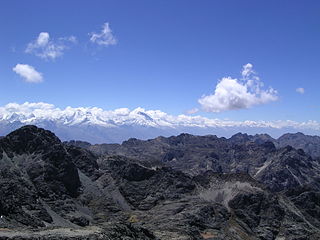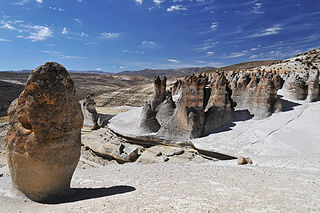
Lake Titicaca is a large, deep, freshwater lake in the Andes on the border of Bolivia and Peru, often called the "highest navigable lake" in the world. By volume of water and by surface area, it is the largest lake in South America.

Ancash is a department of northern Peru. It is bordered by the departments of La Libertad on the north, Huánuco and Pasco on the east, Lima on the south, and the Pacific Ocean on the west. Its capital is the city of Huaraz, and its largest city and port is Chimbote. The name of the region originates from the Quechua word anqash, from anqas (blue) or from anka (eagle).

Viscachas or vizcachas are rodents of two genera in the family Chinchillidae. They are native to South America and look similar to, but are not closely related to rabbits. The viscacha looks much like a rabbit due to convergent evolution.

The Colca Canyon is a canyon of the Colca River in southern Peru, located about 160 kilometres (99 mi) northwest of Arequipa. It is Peru's third most-visited tourist destination with about 120,000 visitors annually. With a depth of 3,270 metres (10,730 ft), it is one of the deepest in the world. Its length is about 70 kilometres (43 mi). The Colca Valley is a colorful Andean valley with pre-Inca roots, and towns founded in Spanish colonial times, still inhabited by people of the Collagua and the Cabana cultures. The local people maintain their ancestral traditions and continue to cultivate the pre-Inca stepped terraces, called andenes.

Lake Lauricocha is a lake in the Andes mountains of central Peru, within Huánuco Region.

Cajatambo or Kashatampu is the capital of the Cajatambo Province in the Lima Region of Peru.

Salinas y Aguada Blanca National Reserve is a protected area located in the regions of Arequipa and Moquegua; Peru. The main purpose of this area is to protect the local flora, fauna and landscape formations.

Ampay National Sanctuary is a wildlife sanctuary established in 1987. It is located in the district of Tamburco, just north of the city of Abancay, Peru. Its 36.35 square kilometres (14.03 sq mi), which include Mount Ampay, protect the Pachachaca River basin and several endangered plant species, being the most representative the conifer called Intimpa.

Sunchubamba is a game reserve in the region of Cajamarca, Peru.
The Vizcachas River is a river in the south of the Patagonic province of Santa Cruz, Argentina. It is born at the Sierra de los Baguales, from the confluence of several streams, and descends from the Vizcachas Plain, flowing south until reaching a low-lying marsh area. At the 51° S parallel, it turns abruptly west until reaching the border with Chile, which it follows and then crosses.

Lauca National Park is located in Chile's far north, in the Andean range. It encompasses an area of 1,379 km2 of altiplano and mountains, the latter consisting mainly of enormous volcanoes. Las Vicuñas National Reserve is its neighbour to the south. Both protected areas, along with Salar de Surire Natural Monument, form Lauca Biosphere Reserve. The park borders Sajama National Park in Bolivia.

The Chilean Coastal Range is a mountain range that runs from north to south along the Pacific coast of South America parallel to the Andean Mountains, extending from Morro de Arica in the north to Taitao Peninsula, where it ends at the Chile Triple Junction, in the south. The range has a strong influence on the climate of Chile since it produces a rain shadow to the east. Because of this the vegetation growing on the seaward slopes is much more exuberant than in the interior. Compared to the coastal lowlands and the Intermediate Depression, it is sparsely populated with land use varying from protected areas to grazing and silviculture. The range is present in all Chilean regions, except for Coquimbo Region and Magallanes Region.

Yungay district is a district in the Province of Yungay in the Ancash region, Peru. It was created by law on October 28, 1904.

The northern viscacha is a species of viscacha, a rodent in the family Chinchillidae. It is known from Peru and Chile, at elevations from 300 to 5000 m, and may also be present in Bolivia.

The plains viscacha or plains vizcacha is a species of viscacha, a rodent in the family Chinchillidae. It is the only living species within the genus Lagostomus. It is found in Argentina, Bolivia, and Paraguay. The plains viscacha is the largest species in its family. They construct elaborate burrows that house successive colonies for decades.

The plains viscacha rat, plains vizcacha rat, red viscacha rat, or red vizcacha rat is a species of rodent in the family Octodontidae native to Argentina. It is one of three species in the genus Tympanoctomys.

The Paiján culture was an archaeological culture that developed on the northern coast of Peru between 8,700 and 5,900 BCE. It was first described by Peruvian archaeologist Rafael Larco Hoyle in the 1940s from the Pampa de los Fósiles site. Later research, mainly by French archaeologist Claude Chauchat, identified dozens of open air sites, which include camps, workshops and quarries.

Vizcachas is a 5,354-metre-high (17,566 ft) mountain in the Andes of southern Peru. It is situated in the Moquegua Region, Mariscal Nieto Province, Carumas District, and in the Tacna Region, Candarave Province, Candarave District. The mountain lies south-east of Vizcachas Lake.

Iscailarjanco is a 5,415-metre-high (17,766 ft) mountain in the Andes of southern Peru It is located in the Puno Region, El Collao Province, Santa Rosa District, and in the Tacna Region, Candarave Province, Candarave District. It is southwest of Loriscota and southeast of Vizcacha Lake. Iscailarjanco lies northeast of Cancave, southwest of Pantiuso and south of Larjanco.
















